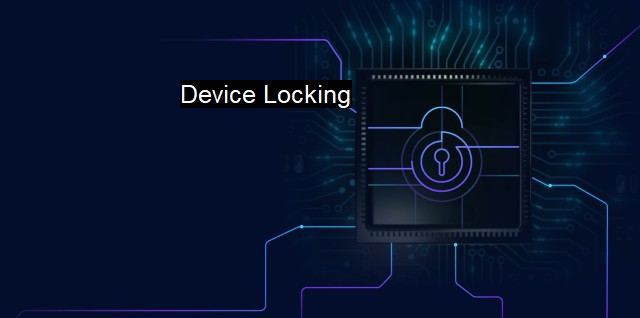What is Device Locking?
Securing Devices from Unauthorized Access: The Importance and Function of Device Locking in Cybersecurity
Device locking is a cybersecurity measure implemented to enhance data protection on various digital devices, such as desktops, laptops, mobile phones, and other removable media drives. It refers to restricting access to a specific device, either through password protection or other forms of authenticated logins, including biometric recognition, pin codes, pattern locks and more.The principle behind device locking is simple - to mitigate unauthorized access. unauthorized access often leads to data breaches with potentially severe consequences. Leaked sensitive, proprietary or personal information could be used maliciously in a range of activities, including identity theft, financial fraud, or even an organization's intellectual property breaches.
Device locking represents the first line of defense in a multi-tiered security strategy and is paramount to any other sophisticated cybersecurity mechanisms in place. Without it, any other protective measure can be bypassed by directly accessing the physical device.
This crucial aspect of cybersecurity becomes even more necessary in the modern world where workforces are increasingly mobile. Using their handheld devices and laptops, employees carry out office work from off-centre locations or even their homes. Thus, the risk of device loss or theft increases. Unlocked devices in such circumstances present a ripe opportunity for unscrupulous adversaries to gain unauthorized access.
Another unique angle to device locking that underscores its criticality relates to malware and viruses. While there exist many forms of sophisticated malware, often, they require some initial access to a device to execute their malicious agendas. Device locking hampers this primary touchpoint.
To enable efficient device locking, one doesn't need groundbreaking technology but just basic security procedures. For consumer devices such as smartphones and laptops, securing the devices with strong unique passwords, patterns or biometric features is crucial. For corporate devices, those procedures are coupled with security standards issued by the company's IT department to manage all electronic devices.
More complex and archetypal technologies for device locking can also be used in high-security risk contexts. in government or military organizations, advanced biometrics including iris scanners, fingerprints, voice recognition, and even gait recognition are employed.
Enterprise mobility management (EMM) is increasingly employed by organizations for dealing with device-related security. EMM systems not only enable device locking but can also enforce security procedures such as remotely wiping a device's data if a breach is suspected.
Device locking, as with any security measure, is not entirely failsafe. High-end hackers could potentially crack even the strongest of security measures, password protections could be forgotten or leaked, and biometric features can be fooled. Therefore, a layered approach including firewalls, encryption, antivirus and anti-malware software, and regular system updates should complement device locking.
Device locking is a fundamental component in today's cybersecurity framework. As technology advances and devices continue to house an increasing amount of sensitive data, it becomes even more vital to ensure that strict device locking policies are implemented and regularly updated. Its conjunction with other protective measures forms an formidable defense against potential cybersecurity threats.

Device Locking FAQs
What is device locking?
Device locking is a security mechanism that prevents unauthorized access to a device. It involves setting up a password or a PIN code to prevent someone from accessing the device without permission. This is an essential security feature on computers, smartphones, and other devices to protect user data and prevent cybersecurity threats.How does device locking prevent cyber threats?
Device locking prevents cyber threats by restricting unauthorized access to a device where sensitive data is stored. Cybercriminals who gain access to unprotected devices can install malware, steal data, or launch cyber attacks. With device locking in place, unauthorised access is prevented, reducing the risk of cyber threats.What are the different types of device locks?
There are different types of device locks such as password, PIN code, biometric authentication (such as fingerprint or facial recognition), or pattern lock. The best type of lock will depend on the specific device and user preferences. A secure password or PIN code is still the most effective way to protect a device from unauthorized access.How can I ensure my device lock is secure?
To ensure your device lock is secure, you should create a strong password or PIN code that includes a mix of letters, numbers, and symbols. Avoid using easily guessable information, such as your name or birthday, and never share your password or PIN code with anyone. Additionally, make sure to keep your device software up-to-date and use antivirus software to protect against cyber threats that can bypass the device lock.| | A | | | B | | | C | | | D | | | E | | | F | | | G | | | H | | | I | | | J | | | K | | | L | | | M | |
| | N | | | O | | | P | | | Q | | | R | | | S | | | T | | | U | | | V | | | W | | | X | | | Y | | | Z | |
| | 1 | | | 2 | | | 3 | | | 4 | | | 7 | | | 8 | | |||||||